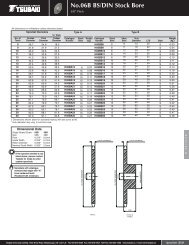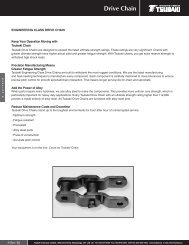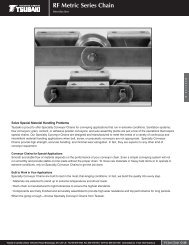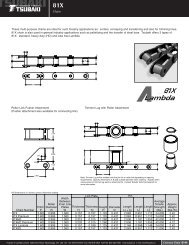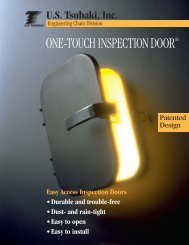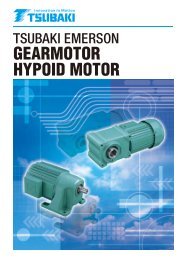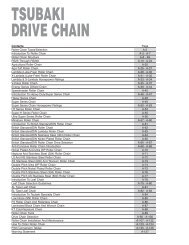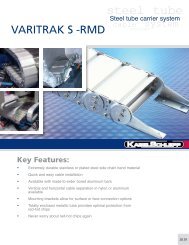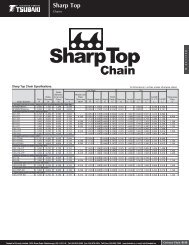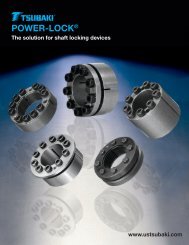DRIVE CHAINS - Tsubaki
DRIVE CHAINS - Tsubaki
DRIVE CHAINS - Tsubaki
Create successful ePaper yourself
Turn your PDF publications into a flip-book with our unique Google optimized e-Paper software.
Handling of roller chain and sprocket7.2 Inspection intervalsRegular inspection of roller chain is recommend atone month intervals. Inspection should be carried outat shorter intervals in:1)2)3)Special or corrosive environments.High speeds with sudden stoppage.Lifting or indexing operations.7.3 Inspection requirements for ordinary transmission1) Inspection lubrication conditionsDuring operation, check to see if there is lubrication inthe clearance between the outer plate and inner plate.Also, check if the chain or rotating disc is immersed inlubricating oil.When the chain is stationary, the chain surface willgenerally appear dirty from wear dust if lubrication isunsatisfactory. This is especially the case between thelink plates.When the chain is removed, connecting link pins and theedge of the inside of the bushes should be checked. Ifthere are any scratches, red or reddish-brown color,lubrication is improper or insufficient.2) Inspecting link platesIf repeated loads over the maximum allowable loadare put on the chain, there is a strong possibility offatigue breakage of the link plate. It is difficult tonotice initial cracking from fatigue breakage simplyfrom external observation.Usually, a crack develops at the edge of a holeor at the side of the link plate, as shown in theillustrations below. The presence of cracks shouldbe checked carefully. Fatigue breakage progresseslittle by little, so it can be noticed with closeattention.Positions where cracksare likely to developFig. 23 Cracks on the link platesExample of a crackWhen wear occurs from sliding between the edgesof the plates and the guides, it is necessary toadjust the position of either the chain or theguides. The allowable wear on the link plates islimited to 5% of their height.H 5Fig. 24 Wear on the edges of the link plates3) Inspecting PinsWhen the pins rotate, the roller chain must becompletely replaced with new chain. This alsoapplies to the connecting pins. By removing theconnecting parts it is possible to see the conditionsof wear and rust on the surfaces of the pins.Correct position Rotated positionFig. 25 Rotation of the pins4) Inspecting rollersAs with the link plates, if rollers are also subjectedto loads over the maximum allowable load, therepeated impact load between the chain and thesprockets may cause fatigue breakage to occur.The roller should be checked in the same way asthe link plate.If foreign objects interfere with the engagement ofthe roller and sprocket, the roller may be damagedand a crack may develop. Careful attention shouldbe paid to the above. Furthermore, with high-speedoperations, even if foreign objjects do not interferewith engagement, cracks may appear from theimpact with the sprocket teeth.Fig. 26 Cracks on the rollersChains damaged by fatigue breakage from therollers must be completely replaced, as each parthas received the same amount of repeated load.Also check for poor roller rotation.5) Inspecting sprocketsChain and sprocket engagement can bechecked by observing the roller and teethsurface. Proper engagement is when the contactarea is uniform with point A in the illstration. If thecontact area is lopsided or the sides of the teethare wearing away (point B), this may have beencaused from improper installation of thesprockets or twisting of the roller chain. In thiscase, rechecking/readjustment is necessary.The normal point of impact is slightly up from thetooth bottom. However, when initial tension isapplied to the chain and tension remains on theslack side, the roller will slightly touch the toothbottom. However, point A receives the strongestimpact.Before Use For Safe Use Standard Roller Chains Lube-Free Roller Chains Heavy Duty Roller Chains Corrosion Resistant Roller Chains Specialty Roller Chains Accessories Selection Handling166



